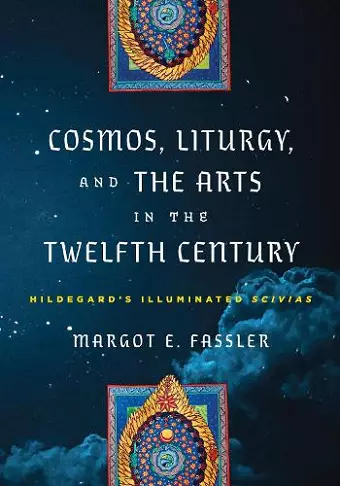Cosmos, Liturgy, and the Arts in the Twelfth Century
Hildegard's Illuminated "Scivias"
Format:Hardback
Publisher:University of Pennsylvania Press
Published:6th Dec '22
Currently unavailable, and unfortunately no date known when it will be back

In Cosmos, Liturgy, and the Arts in the Twelfth Century, Margot E. Fassler takes readers into the rich, complex world of Hildegard of Bingen’s Scivias (meaning “Know the ways”) to explore how medieval thinkers understood and imagined the universe. Hildegard, renowned for her contributions to theology, music, literature, and art, developed unique methods for integrating these forms of thought and expression into a complete vision of the cosmos and of the human journey. Scivias was Hildegard’s first major theological work and the only one of her writings that was both illuminated and copied by scribes from her monastery during her lifetime. It contains not just religious visions and theological commentary, but also a shortened version of Hildegard’s play Ordo virtutum (“Play of the virtues”), plus the texts of fourteen musical compositions.
These elements of Scivias, Fassler contends, form a coherent whole demonstrating how Hildegard used theology and the liturgical arts to lead and to teach the nuns of her community. Hildegard’s visual and sonic images unfold slowly and deliberately, opening up varied paths of knowing. Hildegard and her nuns adapted forms of singing that they believed to be crucial to the reform of the Church in their day and central to the ongoing turning of the heavens and to the nature of time itself. Hildegard’s vision of the universe is a “Cosmic Egg,” as described in Scivias, filled with strife and striving, and at its center unfolds the epic drama of every human soul, embodied through sound and singing. Though Hildegard’s view of the cosmos is far removed from modern understanding, Fassler’s analysis reveals how this dynamic cosmological framework from the Middle Ages resonates with contemporary thinking in surprising ways, and underscores the vitality of the arts as embodied modes of theological expression and knowledge.
"Fassler takes readers into the rich, complex world of Hildegard of Bingen’s Scivias to explore how medieval thinkers understood and imagined the universe...Though Hildegard’s view of the cosmos is far removed from modern understanding, Fassler’s analysis reveals how this dynamic cosmological framework from the Middle Ages resonates with contemporary thinking in surprising ways, and underscores the vitality of the arts as embodied modes of theological expression and knowledge." * Studi Medievali *
"Cosmos, Liturgy, and the Arts in the Twelfth Century is a work of immense creativity and vision, displaying Fassler at the peak of her synthetic powers. In it, she brings to light Hildegard’s coherent (and unique) mode of describing and understanding the universe — as represented in the illuminated Scivias (literally, 'know the ways') — to amplify and deepen our picture of 'the grander scheme of knowing' in the twelfth century. Hildegard, and through her Fassler, are dealing with the deepest mysteries of the cosmos." * Journal of Religious History *
"Margot Fassler is the most important Hildegard scholar now writing in the United States, and this book has been long awaited." * Barbara Newman, Northwestern University *
"Margot Fassler’s fascinating new book opens up for readers the deeply creative work of Hildegard of Bingen, as this medieval Benedictine nun articulates a vision of the cosmos, creation, and worship of God all intertwined. What emerges in Fassler’s study of Hildegard’s Scivias—its texts, music, and images—is a feast for the senses as well as for the imagination." * Teresa Berger, Yale Divinity School *
ISBN: 9781512823073
Dimensions: unknown
Weight: unknown
392 pages